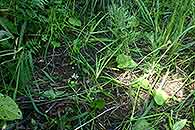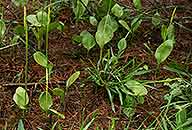Ophioglossum reticulatum L.
Synonyms |
Ophioglossum vulgatum L. var. reticulatum (L.) D.C. Eaton |
|---|---|
Common name |
|
Description |
Rhizome linear to oval, (5-)10-18(-28) mm long, (2-)2.5-4(-6) mm wide often arising from a horizontal root; roots fleshy, horizontal, sometimes descending, proliferous; leaf bases not persistent. Leaves 1 to 2 (sometimes up to 4), held at 50-80% from the horizontal, bright green. stipe (25-)43-131(-145) mm long, 35–60% of its length subterranean, stipe:lamina lenght ratio2.1-1.5:1, stipe bases not persistent. Sterile lamina (20-)24-77(-107) mm long × (14-)20-56(-67) mm wide, circular to broadly ovate, length:width ratio <1.5–2.1:1, apex pointed with a short mucro to rounded, base deeply notched to truncate, texture fleshy. Fertile spike (49-)80–250 mm long, fertile spike:lamina lenght ratio 2.2-4.1:1, inserted at the base of the lamina or up to 2 cm below the apparent base, with 15–47 pairs of sporangia, apex narrowly to broadly pointed. |
Notes | O. reticulatum could be confused with O. vulgatum and O. polyphyllum. O. vulgatum has a tapering leaf base and mostly a single leaf that is lanceolate to narrowly ovate in outline. O. polyphyllum has conspicuous persistent petiole bases at the top of the rhizome. |
Derivation | reticulatum: netlike, like a network; referring to the venation pattern. |
Habitat | Wet sheetrock mats, montane grasslands, moist woodland, dry forests, forest margins. |
Distribution worldwide | Africa, Asia, Indian Ocean Islands, Central and South America, Madagascar. |
Distribution in Africa |
Angola, Benin, Burkina Fasso, Burundi, Cameroon, Central African Republic, Chad, Congo, Dem. Republic of Congo, Equatorial Guinea (incl. Bioko), Ethiopia, Gabon, Ghana, Guinea, Ivory Coast, Kenya, Liberia, Malawi, Mali, Mozambique, Sudan and South Sudan, Swaziland, Tanzania , Zambia, Zimbabwe. |
Growth form |
Terrestrial. |
Literature |
|




